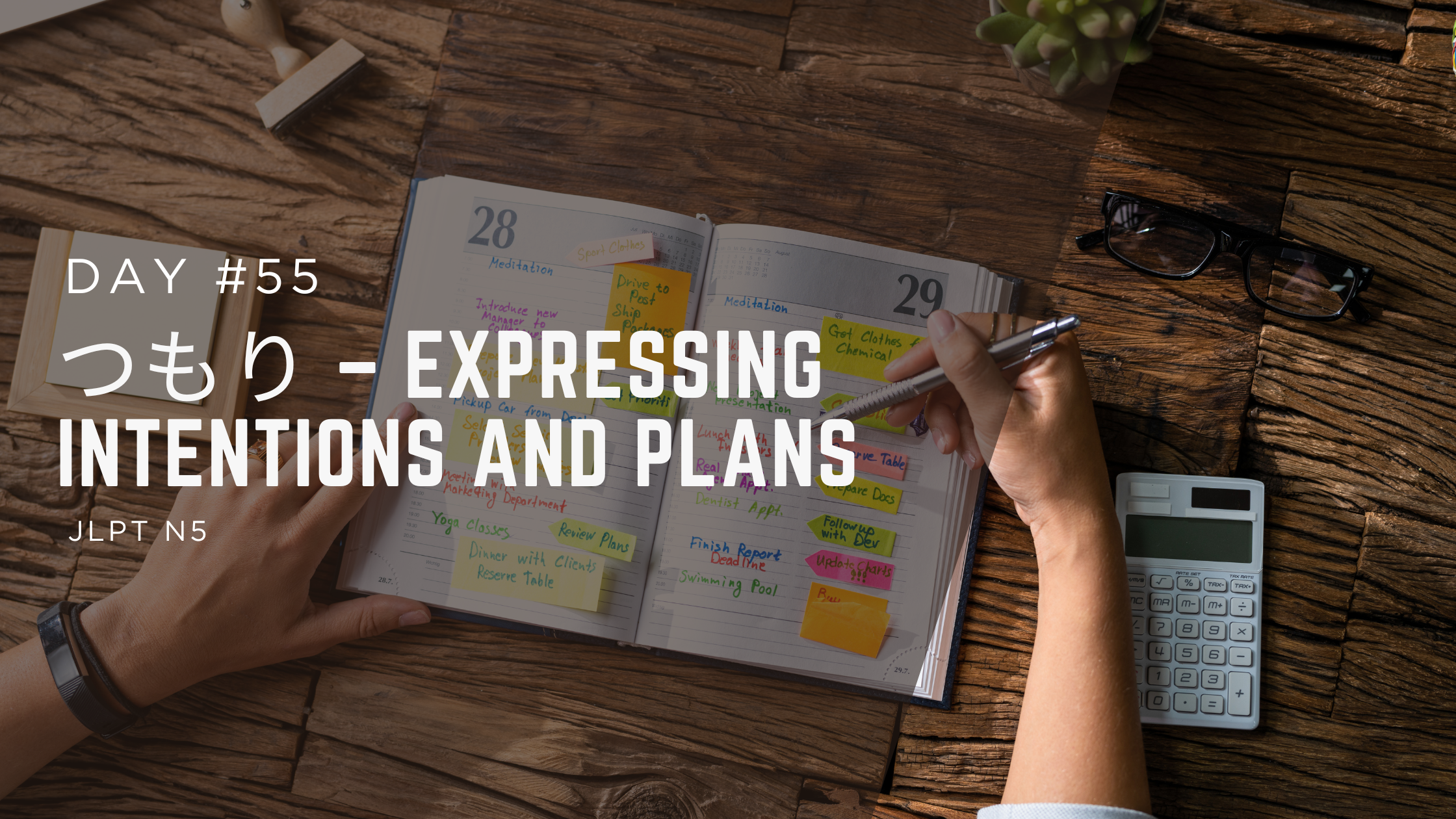Welcome to Day 55 of your 100-day JLPT N5 adventure—you’re over halfway, and that’s massive progress!
We’re focusing on つもり (tsumori), which means “intend to” or “plan to,” letting you say things like “I plan to study” or “I intend to buy a car.”
Let’s get intentional and boost your JLPT N5 prep!
Main Lesson: Understanding つもり
Grammar Rules
Meaning:
つもり expresses intention or plan (e.g., “I intend to go”).
Focuses on your mindset for future actions.
Structure:
[Verb plain] + つもり + です (polite) or だ (casual).
E.g., いく つもり です = I plan to go.
Negative: [Verb plain neg] + つもり + ない/ありません.
E.g., いかない つもり です = I don’t plan to go.
Past: [Verb plain] + つもり だった.
E.g., いく つもり だった = I intended to go (but didn’t).
Questions: [Verb] + つもり です か?
E.g., いく つもり です か? = (Do you plan to go?).
Vocabulary List
Verbs:
| Words | + つもり | English |
|---|---|---|
| みる | みる つもり | see/watch |
| かう | かう つもり | buy |
| べんきょう する | べんきょう する つもり | study |
| やすむ | やすむ つもり | rest |
| たべる | たべる つもり | eat |
Nouns:
| Words | Romaji | English |
|---|---|---|
| えいが | eiga | movie |
| くるま | kuruma | car |
| にほんご | nihongo | Japanese (language) |
| やすみ | yasumi | vacation |
| レストラン | resutoran | restaurant |
Adjectives:
| Words | Romaji | English |
|---|---|---|
| たかい | takai | expensive |
| やすい | yasui | cheap/easy |
| おもしろい | omoshiroi | interesting |
| つまらない | tsumaranai | boring |
Example Sentences
あした えいが を みる つもり です。
(Ashita eiga o miru tsumori desu.)
– I plan to watch a movie tomorrow.
くるま を かう つもり だよ。
(Kuruma o kau tsumori dayo.)
– I intend to buy a car.
にほんご を べんきょう する つもり です か?
(Nihongo o benkyou suru tsumori desu ka?)
– Do you plan to study Japanese?
げつようび は やすむ つもり だった。
(Getsuyoubi wa yasumu tsumori datta.)
– I intended to rest on Monday (but didn’t).
レストラン で たべる つもり じゃ ない。
(Resutoran de taberu tsumori ja nai.)
– I don’t plan to eat at the restaurant.
たかい くるま を かう つもり です。
(Takai kuruma o kau tsumori desu.)
– I plan to buy an expensive car.
やすい ほん を かう つもり だ。
(Yasui hon o kau tsumori da.)
– I plan to buy a cheap book.
おもしろい えいが を みる つもり だった けど、やめた。
(Omoshiroi eiga o miru tsumori datta kedo, yameta.)
– I planed to watch an interesting movie, but I didn’t.
Explanation of “そのつもりです”
“そのつもりです” means “I intend to do that” or “That’s my plan/intention,” where “その” refers to something mentioned earlier in the conversation or context. It’s commonly used to confirm or clarify your plans in response to someone else’s statement or question.
Why “そのつもりです” Works, but Not “この” or “あの”
The nuance here is tied to context. “その” points to something specific and previously mentioned, making “そのつもりです” natural when responding to or aligning with a prior topic.
On the other hand, “このつもりです” (using “この” for “this”) and “あのつもりです” (using “あの” for “that over there”) feel awkward because they imply introducing a distant intention without clear reference, which doesn’t fit the grammar’s purpose.
Native speakers use “その” to stay connected to the ongoing conversation.
Example Sentences
A: あした、かいぎ に でます か?
(Ashita, kaigi ni demasu ka?)
– Are you coming to the meeting tomorrow?
B: はい、そのつもりです。
(Hai, sono tsumori desu.)
– Yes, I will.
Common Mistakes
- Using Masu Form: Adding ます before つもり.
Wrong: いきます つもり です。
Correct: いく つもり です。 - Negative sentence:
Wrong: いきません つもり です。
Correct: いかない つもり です。
Conclusion
You’ve grasped つもり, sharing intentions like “I plan to watch a movie” for future talks.
Love learn Japanese for beginners? Subscribe/share!



